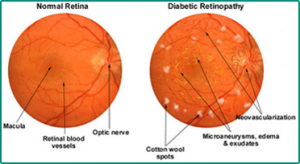In the June 10, 2003 edition, following page24, of The Medical Post there was a minisymposium on obesity and the metabolic syndrome (also known as the “syndrome of hyperinsulinism”).
Four specialists had a discussion about this topic: Dr. Ehud Ur (endocrinologist, Dalhousie University, Halifax, N.S., Canada), Dr. Robert Dent (Director of the Weight Management Clinic, Ottawa Hospital, Ont.), Dr. Dominique Garrel (Director of Department of Nutrition and endocrinologist, University of Montreal, Quebec), and Dr. Arya Sharma (Prof. of Medicine, McMaster University, Hamilton, Ont.).
Introduction:
Obesity is now a health threat that about 25% of the North American population is suffering from. There is still a lot of discussion what the exact criteria should be, but the Third Report of the National Cholesterol Education Program Expert Panel on Detection, Evaluation, and Treatment of High Blood Cholesterol in Adults (ATP III) has simplified the detection of the metabolic syndrome.
The experts agree that when three or more of the criteria mentioned in this table are positive the person would be considered to have metabolic syndrome.
There is a wide age-related variety: in one study only 7% had metabolic syndrome in the age group of 20 to 29. The same study found 40% of study participants had the metabolic syndrome in the age group of 70 years and older. It is thought that too many calories coupled with too little activity over a longer period of time, perhaps coupled in some people with a genetic tendency to develop metabolic syndrome, leads to an accumulation of abdominal (so-called”visceral”) fat.
Because fat cells have their own hormone systems (leptins etc.) there is a change of metabolism including an elevation of the insulin level with associated loss of “insulin sensitivity”. So, the more obese a person becomes, the less effective insulin becomes in transporting blood sugar through cell walls. At the same time the liver metabolism is changing with the good cholesterol (HDL) being less produced and the bad cholesterol (LDL) being overproduced. The liver will produce a different mix of coagulation factors, which leads to a tendency to form clots in the veins of the legs and in the lungs. As the pancreatic capacity for insulin production gets exhausted over a period of time, the patient eventually develops type 2 diabetes mellitus. Due to the risk of the coronary arteries clogging up with the cholesterol changes and the accelerated hardening of arteries from diabetes, the risk for getting severe heart attacks in obese people with the metabolic syndrome when compared to a normal weight population is about 4-fold.
| Elements leading to the diagnosis of “metabolic syndrome” | |
| Finding: | Comments: |
| abdominal obesity | waist circumference more than 102 cm in men or more than 88 cm in women |
| elevated triglyceride level | level of 150 mg/dl or higher |
| low HDL cholesterol level | under 40 mg/dl in men or under 50 mg/dl in women |
| elevated blood pressure | systolic or diastolic blood pressure exceeding 130/85 mm Hg |
| high fasting blood glucose level | fasting glucose higher than 110 mg/dl |
Treatment of metabolic syndrome:
The experts agreed that a reduction of only 5% to 10% of the body weight through a sensible combination of a mild exercise program (e.g. walking 30 to 45 minutes every day) and a calorie reduced food intake will make a significant difference in terms of normalization of the body chemistry. It is my estimate that perhaps 70% to 90% of all cases of obesity and metabolic syndrome can be treated this way.
However, the remaining cases should continue to see their physician and be followed like the doctor would follow someone who has high blood pressure. There are two types of medications available and they have nothing to do with the Phen-Fen diet pills from not too long ago that were found to cause pulmonary hypertension. These new diet pills are fairly safe and show weight loss results provided the patient co-operates with regard to a modified to low fat diet and some degree of regular exercise.
1. Sibutramine (brand name: Meridia) is a specific brain hormone inhibitor in the area where the appetite zone is located (serotonine and norepinephrine reuptake inhibitor). This medication helps the patient by experiencing satiety sooner so that the patient does not feel deprived despite less calorie consumption.
It is the medication of choice for those who tend to eat a lot. Like with other anti-depressants side-effects are a dry mouth, heart rate increases and sleep loss (insomnia).
2. Orlistat (brand name: Xenical) inhibits fat uptake at the level of the gastrointestinal wall (gastrointestinal lipase inhibitor). This leads to an inhibition of fat absorption by about 30%. The patient needs to keep the fat intake down to about 2 oz. (=60 gm) per day. If the patient consumes more fat, the side-effect of orlistat will be flatulence, abdominal cramps and diarrhea. If the patient is on a strict low fat diet, there would not be enough fat in the gut for the medication to be effective.
At this point it is not known how long the patient should be on such weight loss medication, if this was the chosen route. The experts felt that 1 year would be reasonable, but that the patient should be observed by the treating physician and it may be necessary after some intermission to go for another year of therapy all the way attempting to permanently change eating and exercise habits as an ongoing maintenance program.
Here is a link to another reference about the metabolic syndrome (syndrome of insulin resistance).
Last edited December 9, 2012












